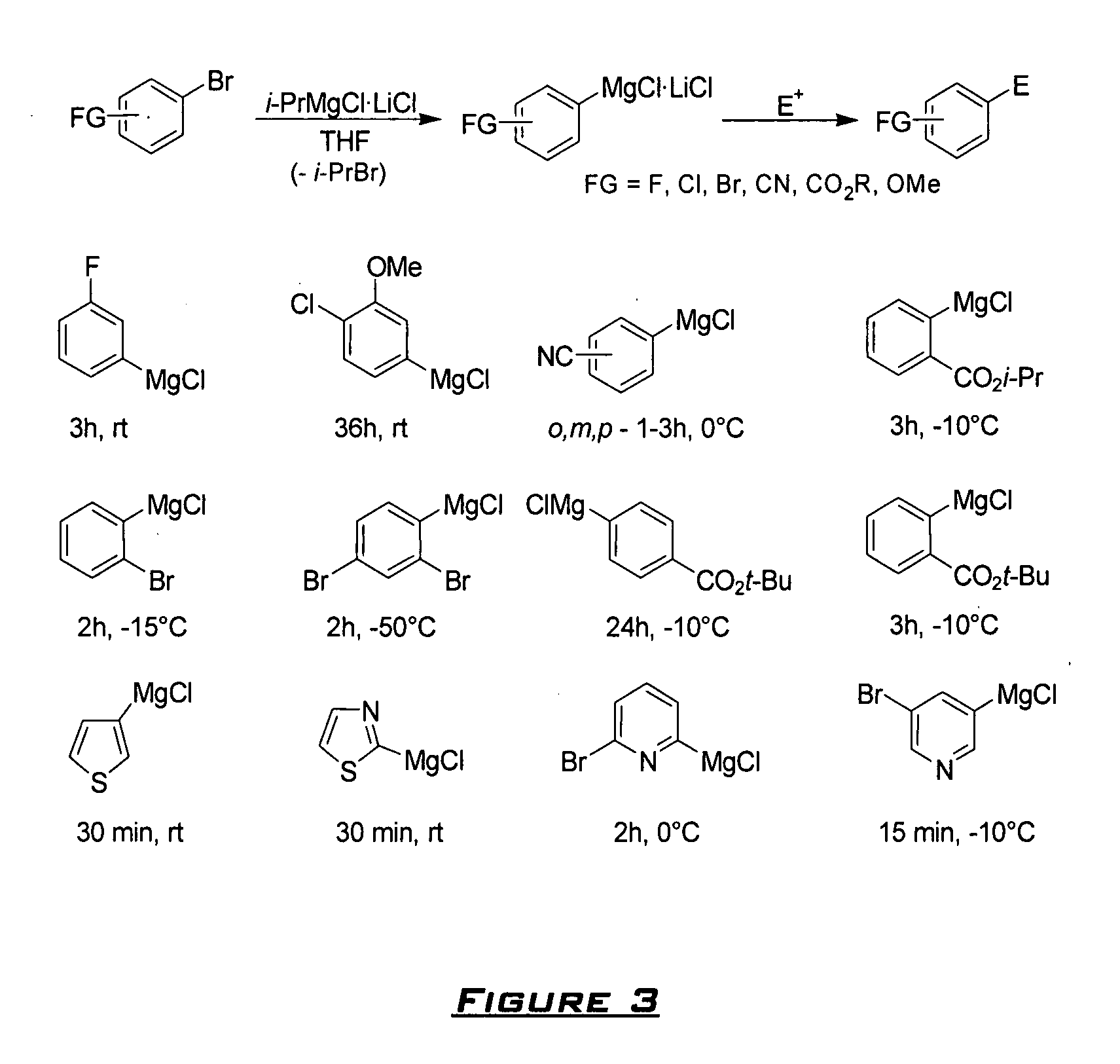Method of preparing organomagnesium compounds
a technology of organomagnesium compounds and organic iodides, which is applied in the field of organomagnesium compound preparation, can solve the problems of low yield, low yield, and inability to use often unstable organic iodides, and achieves the effect of reducing the number of organic iodides in the field, and reducing the number of organic iodides in the field, and reducing the number of organic iodides
- Summary
- Abstract
- Description
- Claims
- Application Information
AI Technical Summary
Benefits of technology
Problems solved by technology
Method used
Image
Examples
example 1
Preparation of the Reagent i-PrMgCl.LiCl
[0090] Magnesium turnings (110 mmole) were placed in an Ar-flushed flask with anhydrous LiCl (100 mmole) and 50 ml of THF were added. The solution of i-PrCl (100 mmole) in 50 ml of THF was added slowly and the mixture was stirred at rt and the Grignard formation starts within a few minutes. The reaction mixture was stirred after the completing of exothermical reaction for additional 12 h at rt. Slightly dark solution of i-PrMgCl.LiCl was transferred to a new flask under Ar and removed in this way from excess of Mg.
[0091] Typical procedure. Preparation of Phenyl-(4-cyanophenyl)methanol 2da. A dry and argon flushed 10 mL flask, equipped with a magnetic stirrer and a septum, was charged with 4-bromobenzonitrile (182 mg, 1 mmole). Dry THF (1 mL) was added, the reaction mixture was cooled to −7° C. and i-PrMgCl.LiCl (1 mL, 1.1 M in THF, 1.1 mmole) was then added dropwise. The Br / Mg-exchange was complete after 3 h (checked by GC analysis of reacti...
example 2
Improved Behavior of Reagents (R1)2Mg.LiY
[0097] The reaction of aryl bromide 1 with i-PrMgCl.LiCl leads only to mixture, whereas with i-PrMgCl.LiCl in THF with the addition of 15-crown-5 leads to 91% conversion to the corresponding Grignard reagent 2.
TABLE 3Effect of the Addition of Additives on the Formation of4-Methoxyphenylmagnesium Chloride at 25° C. After 24 HourReaction Time (1M solution in THF).EntryAdditiveEquiv.Conversion. [%][a]1--72LiCl1.031 (iPrMgCl)32 (secBuMgCl)3LiCl1.039[b]4LiCl + 15-C-51.0 / 1.0A: 100B: 100 (6 h)5LiCl + 15-C-51.0 / 0.5A: 886LiCl + 15-C-51.0 / 0.1A: 547LiCl + 18-C-61.0 / 1.0A: 59B: 778LiCl + 12-C-41.0 / 1.0A: 30B: 289LiCl + PEG2501.0 / 10% volA: 64B: 5510LiCl +1.0 / 10% volA: 47MeO(CH2CH2O)3OMeB: 5811LiCl +1.0 / 10% volA: 52MeO(CH2CH2O)4OMeB: 6012LiCl + dioxane1.0 / 10%A: 91 (88)[c]B: 10013LiCl + dioxane1.0 / 5% volB: 7014LiCl + dioxane1.0 / 20% volB: 1001515-C-51.0A: 816dioxane10% volA: 817LiCl + DMPU1.0 / 10% volB: 6018LiCl + MTBE1.0 / 10% volB: 2719LiCl + TMEDA1.0 / 10% vo...
PUM
| Property | Measurement | Unit |
|---|---|---|
| temperature | aaaaa | aaaaa |
| temperature | aaaaa | aaaaa |
| molar ratios | aaaaa | aaaaa |
Abstract
Description
Claims
Application Information
 Login to View More
Login to View More - R&D
- Intellectual Property
- Life Sciences
- Materials
- Tech Scout
- Unparalleled Data Quality
- Higher Quality Content
- 60% Fewer Hallucinations
Browse by: Latest US Patents, China's latest patents, Technical Efficacy Thesaurus, Application Domain, Technology Topic, Popular Technical Reports.
© 2025 PatSnap. All rights reserved.Legal|Privacy policy|Modern Slavery Act Transparency Statement|Sitemap|About US| Contact US: help@patsnap.com



